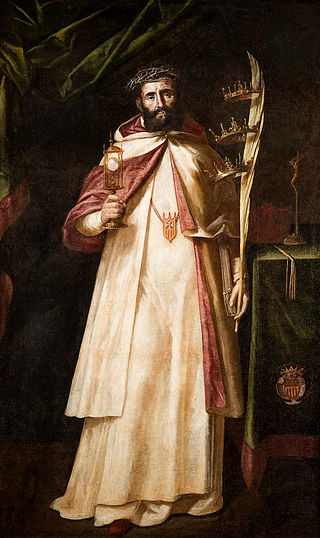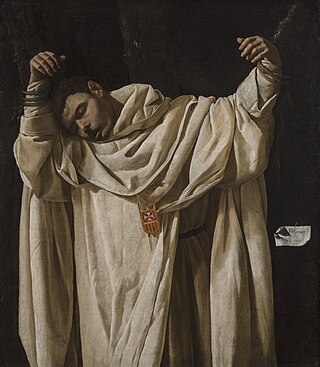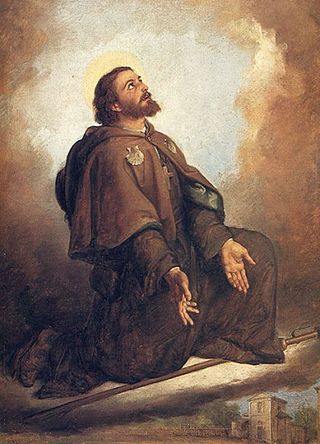
Pedro de Arbués, also known as Peter of Arbués was a Spanish Roman Catholic priest and a professed Augustinian canon. He served as an official of the Spanish Inquisition until he was assassinated in the La Seo Cathedral in Zaragoza in 1485 by Jews and conversos. The veneration of him came swiftly through popular acclaim. His death greatly assisted the Inquisitor-General Tomás de Torquemada's campaign against heretics and crypto-Jews. His canonization was celebrated on 29 June 1867.

Peter Nolasco, Pere Nolasc in Catalan, Pierre Nolasque in French and Pedro Nolasco in Spanish, is a Catholic saint, born at Mas-des-Saintes-Puelles, Languedoc, today's France, although some historians claim he was born in Barcelona.

The Royal, Celestial and Military Order of Our Lady of Mercy and the Redemption of the Captives, also known as the Mercedarians, is a Catholic mendicant order established in 1218 by Peter Nolasco in the city of Barcelona, at that time in the Crown of Aragon, for the redemption of Christian captives. Its members are most commonly known as Mercedarian friars or nuns. One of the distinguishing marks of the Order of the Blessed Virgin Mary of Mercy is that, since its foundation, its members are required to take a fourth vow: to die, if necessary, for another who is in danger of losing their faith. The Order exists today in 17 countries.
Giovanni Battista Righi was an Italian Roman Catholic priest and a professed member from the Order of Friars Minor. He was known for ascetic life and for his preaching and healing abilities.

Raymond Nonnatus, O. de M., is a saint from Catalonia in Spain. His nickname refers to his birth by Caesarean section, his mother having died while giving birth to him.

Albert of Trapani was an Italian Roman Catholic priest and a professed member of the Carmelites. He practiced great austerities upon himself to make himself poor in the spirit of Jesus Christ and went out preaching and evangelizing; he was known for working and maintaining a positive relationship with Jews as well as for his powers of healing. The saint was likewise attributed for the 1301 lifting of the siege in Messina that could have seen hundreds die from starvation had it not been for his intervention.

Szymon of Lipnica was a Polish Roman Catholic priest and a professed member from the Order of Friars Minor. He became a sought after and noted preacher and took as his preaching inspiration Saint Bernardine of Siena and also was a strong proponent of popular devotions that he worked to spread.

Serapion of Algiers was an English Catholic Mercedarian priest and martyr. Thomas O'Loughlin says Serapion was Scottish by birth. Serapion is acknowledged as a proto-martyr. He was the first of his Order to merit the palm of martyrdom by being crucified and cut to pieces.

Stanisław Kazimierczyk was a Polish Catholic priest and a professed member of the Canons Regular of the Lateran. He became noted for his ardent devotions to both the Eucharist and to his personal patron saint, Stanislaus of Szczepanów, as well as for his charitable dedication to the ill and poor of Kraków.

Amato Ronconi was an Italian Catholic who became a professed member of the Secular Franciscan Order. Ronconi lived a life of penitence and dedicated all his works to the poor through the construction of chapels and hospitals – one such hospital still exists in his home of Rimini. His good deeds never went unnoticed for the townspeople hailed Ronconi as a saint in their midst even in the face of a slanderous accusation a jealous sister-in-law spread.

Robert de Turlande was a French Roman Catholic priest and professed member of the Order of Saint Benedict. He was of noble stock and was also related to Saint Gerald of Aurillac. He is best known for the establishment of the Benedictine convent of La Chaise-Dieu and for his total commitment to the poor.

Domenico Spadafora was an Italian Roman Catholic priest and a professed member of the Order of Preachers. Spadafora was a noted evangelist and attracted countless to the Dominican fold while also converting the hearts of others who led dissolute lives. He is best known for being the first superior of a church he oversaw construction of in Monte Cerignone after receiving the papal approval of Pope Alexander VI to commence such work.
Ugolino da Gualdo Cattaneo was an Italian Roman Catholic professed religious and friar of the Order of Saint Augustine. Ugolino is best known for founding an Augustinian convent in Gualdo Cattaneo in 1258 where he served as its prior until his death. He practiced a rigorous spiritual life with austerities including frequent bouts of strict silence and fasting.

Luca Antonio Falcone – in religious life Angelo – was an Italian Roman Catholic priest and a professed member of the Franciscan Order of Friars Minor Capuchin in Cosenza. Falcone had a rough call to religious life after several entries and exits into the order and he later served as a noted preacher across southern Italian cities such as Catanzaro and Salerno after his first few sermons attracted little following. He became titled as both the "Angel of Peace" and the "Apostle of the South".
Giovanni Pelingotto was an Italian Roman Catholic member of the Secular Franciscan Order who hailed from Urbino and lived his life as an almsgiver and hermit. Pelingotto served in his father's business before he quit and provided as much alms as he could provide to the less fortunate in his area. This led him into contact with the Franciscans which served to open him to a greater plane of servitude to God and the poor.
Giacomo Benefatti was an Italian Catholic priest and professed member of the Order of Preachers who ascended to the position of Bishop of Mantua. Benefatti became noted for his tender care of the ill during epidemics of plague and both Pope Benedict XI - a close personal friend - and Pope John XXII held him in high esteem.

Giovannangelo Porro was an Italian Roman Catholic priest and hermit who hailed from the Milanese region and was a professed member of the Servites. Porro was born to nobles and became a priest after the death of his father. He remained a hermit in convents in places such as Florence and Milan where he dedicated his life to inward meditation and self-mortification until his death.
Benincasa da Montepulciano was an Italian Roman Catholic professed religious from the Servite Order. He lived as a hermit in Siena his entire life since he joined the order as a teenager and dedicated himself to a quiet life of servitude to God in contemplation despite still receiving visitors and orders from his superiors.
Antonio da Stroncone was an Italian Roman Catholic professed religious from the Order of Friars Minor. He became a member of that order in his late childhood after cultivating a strong devotion to Francis of Assisi during his childhood with his parents who were also Franciscans.
Angelo of Foligno - born Angelo Conti - was an Italian Catholic priest and a professed friar of the Order of Saint Augustine. Conti was part of the order of John the Good though became a mainstream Augustinian in 1256 after the Grand Union of the order. He was a close friend of both Saint Nicholas of Tolentino and Blessed Ugolino da Gualdo Cattaneo.















